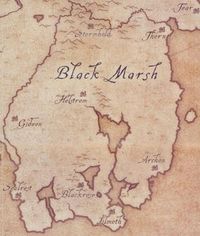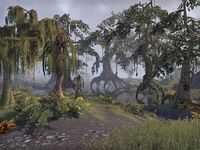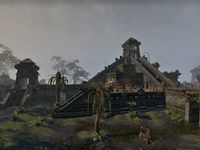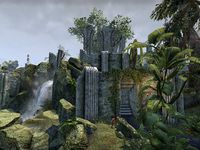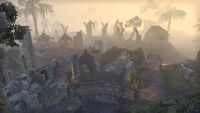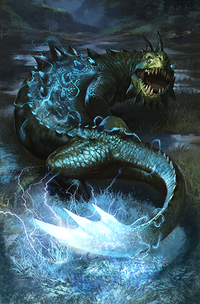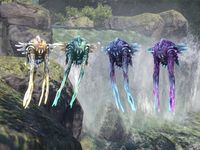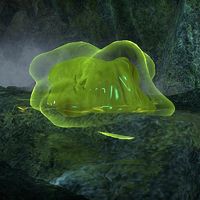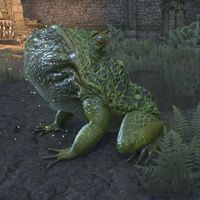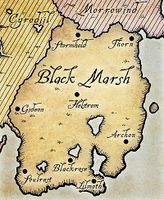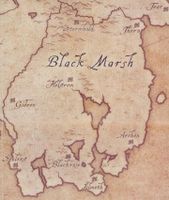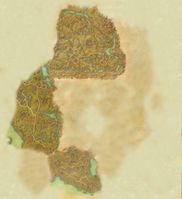Lore:Black Marsh
| This page is currently being redesigned for the Lore Places Project (LPP). The page may need work to meet the standards outlined on the project page. |
| Black Marsh | |
|---|---|
| Type | Province |
| Continent | Tamriel |
| Appears in | Arena, Stormhold, ESO |
Black Marsh is a dense swampland region of southeastern Tamriel, home to the reptilian humanoid race of Argonians and a race of sapient trees known as the Hist. Mer refer to the region as Argonia.[1] The Argonians do not have a word for their homeland in their native language, in part because they do not consider it a singular nation. A member of the Argonian Gee-Rusleel tribe once used the wide-swamp gesture alongside the word kronka-thatith (roughly meaning "everything-egg") to describe the region, which is probably the closest non-Jel speakers will ever get in the way of a "true name" for the region.[2]
The Argonians thrive in the foreboding swamps of Black Marsh, a lush and threatening land teeming with poisonous plants and violent predators. The region's tropical climate lends its plants the capacity to overturn all attempts to cultivate them. Foreign agricultural, colonial, and commercial ventures beyond the slave-trade have met with abject failure.[3] The native Argonians organize themselves on the tribal level with success and efficiency, and were only loosely integrated into the ruling Empire when Cyrodiilic Emperors deigned to lay claim to the land.[4]
Aside from the Argonians, Black Marsh is host to a slew of other sapient peoples. The human inhabitants of Black Marsh (Imperial settlers from the Cyrodiilic Empire notwithstanding) include the Horwalli, the Yespest, and the silver-skinned Kothringi. The Orma, who are predisposed to blindness, are another Mannish race that inhabits the marsh.[5] The serpent-bodied Lamias and the vulpine Lilmothiit (the latter of which lived along the southern coasts) are notable instances of humanoid and semi-humanoid races that live in the region.[6] The Kothringi and the Lilmothiit were driven to extinction by the Knahaten Flu.[7][8]
Geography[edit]
Black Marsh contains various regions, such as Arnesia, the Blackwood Bog,[9] Gloomire (or Gloommire),[10] Middle Argonia, Murkmire, Shadowfen, Thornmarsh and the Ultherus Swamp.[11] Norg-Tzel is a small island off the coast of the Oliis Bay, with similar climate and terrain to Murkmire.[12]
Black Marsh is located in the southeastern part of Tamriel, bordering Morrowind to the north and Cyrodiil to the west.[13] Most of the Argonians reside in the inland waterways and swamps of the southern interior. There are few roads, and the principal method of travel is by boat.[13] The Panther River starts in southern Cyrodiil and flows past the provincial border to the Black Marsh side of Blackwood.[14] The Onkobra River is another river in that starts from the Topal Bay and runs eastward into central Black Marsh.[15]
The soil composition of Black Marsh is varied. The roots of the Hist penetrate dark soil and grow through Black Marsh's soft, white limestone.[16]:34:54 Red clay is prevalent in Blackwood, particularly northeast of Gideon.[15][17]
Fort Swampmoth is an Imperial keep found somewhere in the province.[18] Lilmoth is perhaps Black Marsh's southernmost settlement, situated along the Oliis Bay.[16]
Gideon is a city with stone walls and largely Imperial architecture that was built atop the sunken Ayleid ruin of Twyllbek.[19]
In The Argonian Account, the poor condition of Black Marsh's roads is said to prevent food from arriving fresh at any destination.[20] The main character, Decumus Scotti, describes the goods (grain, meat, and vegetables) of his caravan as being in various stages of rot.[21] In the novella, impediments to road travel are abound: fast-growing grasses that cover important trade routes as quickly as they are cut down, insects known as fleshflies feast on the soft skins of non-natives, rivers that seasonally flood several feet,[21] and bands of Naga raiders that target caravans.[22]
Jarth's novella finds it a solely Imperial desire to make trade land-based, and to build large-scale plantation complexes, denoting it as a desire that has done little good for Black Marsh itself. The novella finishes by having Scotti clear up most issues relating to Imperial interests in Black Marsh, returning travel to its historical form, by boat and Underground Express, and by ceasing Imperial efforts to change Black Marsh's economy from one oriented on subsistence agriculture into one oriented on export crops. As Jarth writes, the situation is that "Black Marsh simply was, is, and always shall be unable to sustain a large-scale, cash-crop plantation economy." In returning to the traditional methods, Jarth's summation of Scotti's accomplishments concludes that the province "was better off than it had been in forty years".[22]
History[edit]
Merethic Era[edit]
The earliest inhabitants of the Black Marsh and its environs are believed to have been the Hist, great life-giving trees of unknown capacities. The region presently known as Black Marsh was once part of a much greater landmass within the domain of the Hist, but the greater part of the region was flooded during the wanderings of the humanoid Mer races. The Annotated Anuad states "The Hist were bystanders in the Ehlnofey war, but most of their realm was destroyed as the war passed over it. A small corner of it survived to become Black Marsh in Tamriel, but most of their realm was sunk beneath the sea."[23] Black Marsh also became home to groups of Men, including the Kothringi, as well as the fox-like Lilmothiit.[7]
At some point, the Argonians developed a unique civilization that inexplicably collapsed long before their first encounters with the other races of Tamriel. A number of forgotten Argonian tribes constructed countless elaborate stone structures across Black Marsh, ranging from solitary statues and Wayshrines to sprawling stepped pyramids known as xanmeers.[4][24] While the purpose of many of these structures, as well as the techniques used to carve and build them, have long been lost to history, many of these structures have been identified to be shrines erected in both reverence to and fear of Sithis, such as the Teeth of Sithis in central Murkmire[25] or the vaults beneath the Sunscale Strand ruins in southern Shadowfen.[26] It is wholly unknown how or why this ancient Argonian civilization disappeared, and the apparent disparity between its enduring, elegant stonework and the makeshift, bulbous mud structures and thatch houses that many subsequent Argonian tribes adopted has perplexed foreign scholars.[4] The mysterious event that caused this collapse and brought about a plethora of changes for Argonian civilization has come to be known as Duskfall.[27]
Following Duskfall, the Argonians of Black Marsh no longer worshipped Sithis the Destroyer and instead chose to follow the teachings of Raj-Sithis the Changer.[28] The Nisswo-Kings lost power and were replaced by the Clutch of Nisswo, a priesthood devoted to collecting and spreading the many contradictory truths of Sithis throughout Black Marsh.[29] The majority of Argonians ceased building with stone to instead allow the marsh to reclaim what they built.[30]
Perhaps most drastically, however, the Hist trees ceased communicating with Argonians altogether following Duskfall. Though the two parties still cared for one another, the Hist remained silent until an Argonian named Jaraleet finally renewed their relationship through re-discovering the practice of ingesting Hist sap.[31] While outsiders may be perplexed and pity the Argonians for the loss of this grand civilization, the Argonians themselves viewed this as a just and fitting end for a society that worshipped only destruction. The majority of modern tribes freely chose to reject mimicking the masonry of their ancestors altogether so that they could fully embrace the change that is Sithis.[32]
First Era[edit]
Some Argonians began to migrate throughout the rest of Tamriel in the early First Era, but these rare expatriates usually assimilated into their adopted homelands and shared little of their native ways with others. Following the expulsion of the Aedra-worshipping Barsaebic Ayleids from Cyrodiil in 1E 198, the Barsaebics took refuge in Black Marsh and established a number of colonies, including what would later become the cities of Stormhold and Gideon.[7][33][34] Consequently, the Barsaebics survived the wrath of Alessian Slave Rebellion decades later, becoming one of the few remaining enclaves of Ayleid civilization in Tamriel before they too dwindled.[7]
Centuries later, the fringes of Black Marsh became safe havens for thieves, pirates, and other outlaws. The problem became so severe that in 1E 1033, Empress Hestra of the Alessian Empire launched a campaign to root out the notorious human pirate "Red" Bramman. The Imperial Fleet delved deeper into Black Marsh than any outsider had ever explored in their pursuit of Bramman, eventually cornering and killing him at his bandit kingdom near modern-day Blackrose.[4] The Empire attempted to civilize the pirate-infested south, gleaning the first detailed accounts of native Argonian culture in the process, but ultimately settled on eradicating the pirates before building prisons for their least desirable convicts, and later abandoned Black Marsh entirely.[7]
In 1E 2811, the last organized army of Argonians was easily defeated by the legions of the Second Empire at the Battle of Argonia.[7] Within the next few decades, Black Marsh was nominally incorporated into the Second Empire as a province. Emperor Reman II squandered thousands of troops and years of effort in his attempts to conquer Black Marsh; in 1E 2837 he declared the region officially annexed, despite only extending the Empire's reach into the northern and eastern marches.[35] Black Marsh remained a province until the Empire's collapse in the mid-Second Era.[1]
Second Era[edit]
The Knahaten Flu started in Stormhold and persisted for 41 years, from 2E 560 to 2E 601. The flu took its toll on the region, driving the Kothringi and the Lilmothiit to extinction. The native Argonians were largely immune to this plague, which led some to falsely believe it was fabricated by an Argonian shaman.[1][7] To the Argonians, the Flu was merely a mild sickness which they called the Half-Swim Sniffles.[2] The last recorded case of the flu was in 2E 603, after a group of Kothringi tribesmen fled Black Marsh by boat and disappeared.[36]what page?
During the Second Akaviri Invasion of 2E 572, remembered as the "Liberation War" among the Argonians, a phalanx of Argonian Shellbacks unexpectedly came to the aid of an allied force of beleaguered Nords and Dunmer who were struggling to contain the cornered Akaviri army.[37][38][39] With the Argonians' help, the Akaviri were slaughtered to the last man before their ships could arrive to evacuate them.[38] The battle engendered a newfound respect between the three races, which resulted in the formation of the Ebonheart Pact.[40]
Under the Pact, Argonian slaves in Morrowind were freed and Black Marsh gained a level of autonomy not seen in centuries. Despite all Argonians being welcomed into the Pact, only the tribes of Thornmarsh, Shadowfen, and Murkmire decided to join.[39][41] The Argonians established a more formal government in the form of the vicecanons, magistrates who administered major settlements in Black Marsh and coordinated with emissaries from Skyrim and Morrowind.[34] Shadowfen was invaded in 2E 582 by the Aldmeri Dominion, which sought to sever the Argonians' connection to the Hist and thereby drive the entire race to extinction. This plot was foiled, and the allied Argonian tribes later reaffirmed their commitment to the Pact.[24] It is unknown how long this period of relative independence for Black Marsh lasted, but the Ebonheart Pact ceased to exist by the end of the Second Era.
Tiber Septim brought Black Marsh into the Third Empire during the Tiber War. Though it is not directly indicated, a passage in the book A Short History of Morrowind implies that Black Marsh was acquired by treaty or pact rather than by military dominion. "Resdayn was the last of the provinces to submit to Tiber Septim; like Black Marsh, it was never successfully invaded, and was peacefully incorporated by treaty into the Empire as the Province of Morrowind."[42]
Imperial rule changed little of the tribal organization of Black Marsh's society, but wrought disastrous changes to its economy as the small farms of Argonian peasants were replaced with massive cash-crop farms and traditional forms of transportation were usurped by foreign methods unsuited to the native terrain. These changes were eventually remedied as the land's administration chose to return to previous methods of business. There have been some small attempts to convert the residents of Black Marsh to the Cyrodilic pantheon of the Nine Divines, but most have been unsuccessful.[22]
Third Era[edit]
During the later years of the Third Era, Black Marsh came into conflict with its Dunmer neighbors to the north in the bloody Arnesian War. The conflict started as a slave revolt in the lands of House Dres, and escalated into a full war when the Argonians captured, tortured, and murdered the Dunmer merchant Roris, who was declared a saint by the Dunmer Temple.[43][44] However, the armies of Black Marsh were defeated, allowing Morrowind to expand its territory into the south.[7] Interestingly, documents prepared for Lord Vivec by the Tribunal Temple imply that Black Marsh retains control of some historically Dunmer provinces, despite the Dunmer victory in the Arnesian War. In detailing Dagoth Ur's plans, the Tribunal Temple noted that he wished to "recover ancient territories stolen by Skyrim and Argonia".[45] The Dunmer and the Argonians, perhaps unsurprisingly, have a "long standing and bitter hatred for one another".[13]
Fourth Era[edit]
After the Oblivion Crisis and the eruption of Red Mountain during the beginning of the Fourth Era, Black Marsh seceded from the Empire along with Elsweyr.[46] Morrowind was substantially weakened when the Ministry of Truth became unstable and crashed into Vvardenfell, destroying much of the island. The Argonians of Black Marsh invaded, at first successfully pushing deep into the country, but then being driven off by the forces of House Redoran. In 4E 48, a floating, soul-fueled city known as Umbriel moved over the city of Lilmoth after being summoned through Black Marsh by the An-Xileel and a rogue Hist tree, destroying and killing all foreign entities and 'assimilated' Argonians.[16] In the late 2nd century of the Fourth Era, the Shadowscales served the king of Black Marsh, who ruled over the province.[47][48]
Fauna[edit]
Black Marsh generally has a southerly marsh-like climate along with the flora and fauna that would be associated with such an environment. Waughin Jarth's The Argonian Account suggests a climate similar to that of neighboring Blackwood, the swampy region east of Leyawiin, though with denser vegetation and less hospitable wildlife.[21]
Black Marsh is home to many different reptilian species. The wamasu is a large predatory reptile with a tough hide that spits lightning. They can be found in many regions throughout the swamp.[49] Bog dogs are mammalian pack animals found in Blackwood,[50] though they aren't related to actual dogs.[51] Crocodiles, known locally as rormasu, are common throughout Black Marsh.[52][53] Snakes are prevalent across the province, including the giant snake of Shadowfen,[54] and the pukta snake and wasso hedge snake which are used in various Argonian dishes.[55][56] The lethally poisonous red hooped tree-viper looks nearly identical to the wasso hedge snake, so picking a trustworthy snake dealer is paramount.[56] Willow vipers are good at camouflage, and best left alone.[57] Moon-adders are venomous vipers. Argonians are resistant to their venom, and use it to make daril.[16]what page? The hulking haj mota and the meat-eating painted tortoise are animals commonly found in Black Marsh.[58][59]
Lizards are diverse in Black Marsh. Some scholars believe the tree-dwelling ancestor lizards are the ancestors of Argonians.[60] Strange scaly quadrupeds known as bear-lizards (or "lizard bears"[61]) reside in south and western Black Marsh.[62] Argonians call these animals "useful lizards", believing that these lizards underwent evolutionary changes similar to themselves.[63] Other lizard species include Murkmire's hedge gecko,[64] the water lizard[65] and the tiny xaht lizard of Blackwood.[66]
Some of the creatures that live in Black Marsh are theorized to be related to animals found in Morrowind.[67] Hackwings are giant birds with long, saw-like beaks nearly the size of the rest of their bodies. They are similar in appearance to cliff striders, and are vicious predators that take advantage of lazy prey.[20] Swamp jellies are floating creatures with elastic, gelatinous bodies that are related to netches. Argonians give the various breeds flavor-themed names based on their hue.[68][67] Kagouti and guar can also be found in Shadowfen, close to the Morrowind border.[69] Mudcrabs, burglar crabs,[70], swamp shrimp[71] and dreugh are crustaceous creatures that live in Black Marsh.[72] The three-clawed mudcrab is a rare variant of mudcrab in Black Marsh.[65]
Fleshflies, blood-colored, sand-grain-sized insects which feast on human flesh, inhabit Black Marsh and southeastern Cyrodiil. Those unlucky enough to be caught by their swarms may find their faces deformed as the creatures eat their skin.[21] Giant wasps can be found in the northern region of Shadowfen,[53] while hoarvors and kotu gava live in the Blackwood Bog to the southwest.[73]. Spear-ants,[74] wood ants,[75] bog ants, and marsh centipedes[65] are other bugs found in the province.
Black Marsh is also home to rootworms, which are referred to as the "Underground Express" by the locals. Rootworms are useful to travelers, swallowing them whole and carrying them with the current. The digestive systems of rootworms are apparently quite slow, and travelers "could live in a rootworm's belly for months." All one needs to do to get off the Underground Express is keep an eye out for pockets of air (signified by bubbles) through the beast's transparent flesh, and push upwards to break through their malleable skin.[15]
Slugs are common in Black Marsh. The Saxhleel use them in cooking, as well as an art known as "slugshaping".[76] Known species include the Jassa Red,[76] Bearded Blue, Black-Banded Slider, and King Yellow.[77]
Voriplasms are blobs of green slime that can strip creatures down to the bone in seconds. Also of note are swamp leviathans, which are massive reptiles with tusks and sharp teeth.[22] Will-o'-wisps are deadly glowing orbs of light found in the deep swamps, and shines are their wispy, yellow, and less dangerous cousins from Murkmire.[16]:17 Coral reefs grow along the coast of Black Marsh, west of Lilmoth. Venin-bats and blood moths are a nuisance to the residents of Murkmire.[16]:46 Miregaunts, great behemoths woven from roots, wander the deep swamps.[78] Marsh Giants are woodland spirits native to Black Marsh, described as "the spriggans' prodigious cousins". Marsh Giants are essential to the ecosystem; as they till soil, fell dead trees to allow new vegatation to flourish, encourage vital moss growth, encourage avian diversity by warding off feral cats, combat invasive fungi, and most importantly, hinder loggers, miners and and other tradesfolk from harming the marsh.[79]
Crows are prevalent in Gloomire, like most everywhere else in Tamriel. They make nests on treetops, as their black feathers allow them to blend well into the dense forests and marshlands.[10] Black cockerels, which live near White Rose, eat toxic beetles that turn their flesh black.[59] Betva-hens are possibly large birds, whose feathers are often worn by Argonian naheesh elders.[80] Another avian species found in Black Marsh is the marsh-robin.[81]
Many frog and toad species can be found in Black Marsh. Aojee toads,[82] dragon frogs, indigo tree frogs, moss-foot croakers, ruby hoppers, and sun-blessed toads can be found near Lilmoth;[83] while glowing frogs and the large, carnivorous death hoppers can be found near Gideon.[84] The nettle-toad is a species that lives in Murkmire and eats slugs; the Saxhleel who leaves a bowl of slugpaste unattended may return to find that a nettle-toad has eaten their fare.[85] Singing frogs are found near the Panther River. These frogs make unique chirping calls, and are prized by Argonian musicians who use them for vossa-satls.[86]
Flounder, trogfish,[16]:197 harpoon-fish,[87] slaughterfish, hog-fish,[88], bog-eels[89] and swamp eels[90] are all examples of fish that live in Black Marsh. Osheeja gars are large river fish used by the Naka-Desh tribe to catch smaller fish.[91] Ripper eels are trained to hunt Argonians illegally crossing canals in Lilmoth, though this can be prevented by rubbing oneself with eel-slime.[16]what page? The geels-ha butcher eel is a massive river predator of Kothringi folklore, that could swallow haj mota whole. Bog-blue jasper is said to come from their gizzards.[92] Sea-drakes and sharks also swim the southern seas.[16]:52 Pad-sa are a species of scrappy sharks usually found along the coast, from the mouth of the Niben River to the Topal Bay.[93]
Black marsh cucumbers and black marsh-squids are some examples of the aquatic animals native to Black Marsh that aren't fish.
The Helstrom crocodile, a much larger species of crocodile; the wraxu, a cousin of the terror bird described by Varid's Guide to Unusual Birds as being as tall as mammoths with tails as long as wagon tongues; and a species of long-legged swamp wolves all went extinct following the Blackwater War and the Great Burn of 1E 2828.[94][80][95] Features of the extinct swamp wolf could be seen in the Blackwood dire wolf circa 2E 582.[95]
Swamp-foxes[96] and mud-moles[57] are examples of other animals that live in Murkmire.
Flora[edit]
Dragon's Tongue and the Somnalius Fern, which are used in alchemical brews, are native to Black Marsh. Dragon's Tongue is a fern-like herb lethal to the touch. It gains its name from the fire-red fronds that surround its golden efflorescence. The Somnalius Fern is light green and delicate and crumbles at the touch. It has the effect of fatiguing the creature that inhales it.[11] Scaldroot is an herb that, when brewed, produces foul-tasting tea that aids in cleaning the teeth.[97] Dragonthorn also grows in Black Marsh. The ancient Argonians believed that chewing dragonthorn leaves helps the body prepare healthy eggs.[98]
Flint vine is a sturdy plant from Murkmire that can be woven into ropes or ladders.[99] Mangrove trees thrive along the western coast of Black Marsh.[16]:50 A thick wall of mangroves thrives along the shore about ten miles from Lilmoth.[16]:53 They form a nigh-impenetrable wall, and look like thousands of giant spiders with their legs interlocked. An Argonian folktale claims that's exactly what they once were. These giant spiders apparently garnered the Hist's wrath during an ancient conflict, and were transformed into trees.[16]:52 Sleeping palms and bamboo thrive in and around Lilmoth, as does lucan mold, which glows with pale phosphorescence.[16]:17 Cattails grow near the water in Murkmire.[57] Stink weeds and swamp grass are plants native to Murkmire that grow back later when cut down.[100] Nightbloom vine, which grows in secluded bogs, is precious to the Naga-Kur.[101]
Plums grow near White Rose, known to Argonians as "lizardfruit".[102] Krona nuts are a nut whose husk is used in Saxhleel coming-of-age rituals.[65] Wasso nut leaves are used in cuisine, and worn as protective padding.[77][103] Wasso fruit is a delicacy in Blackwood.[104]
Bog willow[105] and cypress[106] are two species of tree that grow in the marsh.
Notable Places[edit]
- Alten Corimont
- A freebooter settlement in eastern Shadowfen.
- Archon
- A settlement near the eastern coast of Black Marsh.
- Blackrose
- A settlement in Murkmire, near the Murkwood, known for the Imperial-built Blackrose Prison.
- Bogmother
- A sacred Argonian ruin and former temple village in Shadowfen.
- Gideon
- A settlement on the western border of Black Marsh.
- Helstrom
- A settlement located in the nigh-unexplored interior of Black Marsh.
- Lilmoth
- A major port city on the southern tip of Murkmire, on Oliis Bay.
- Murkwood
- The legendary "dark forest that ever moves", located deep in the swamps of Black Marsh.
- Noota Nara
- A village that existed in the Second Era.
- Soulrest
- A settlement located in the southwestern corner of Black Marsh.
- Stormhold
- A major city in northern Black Marsh, close to the border with Morrowind.
- Thorn
- A settlement in Thornmarsh, near Morrowind.
Gallery[edit]
Maps[edit]
See Also[edit]
Books[edit]
- The Improved Emperor's Guide to Tamriel: Black Marsh by Flaccus Terentius
- Pocket Guide to the Empire, 1st Edition: The Wild Regions by the Imperial Geographical Society
- Pocket Guide to the Empire, 3rd Edition: The War with the Trees: Argonia and the Black Marsh by the Imperial Geographical Society
- Stormhold, City of Shadowfen by Cirantille — A description of the city of Stormhold
- Tips for Black Marsh Travel — An excerpt from a travel guide warning of the dangers in Black Marsh
- Wet Wilds of Black Marsh by Cirantille — An unflattering appraisal of the wilds of Black Marsh
References[edit]
- ^ a b c Pocket Guide to the Empire, 1st Edition: The Wild Regions — Imperial Geographical Society, 2E 864
- ^ a b Loremaster's Archive: Murkmire Q&A Part 2 — Jee-Lar
- ^ The Argonian Account — Waughin Jarth
- ^ a b c d The Improved Emperor's Guide to Tamriel: Black Marsh — Flaccus Terentius, 2E 581
- ^ 2920, The Last Year of the First Era — Carlovac Townway
- ^ Wet Wilds of Black Marsh — Cirantille
- ^ a b c d e f g h Pocket Guide to the Empire, 3rd Edition: The War with the Trees: Argonia and the Black Marsh — Imperial Geographical Society, 3E 432
- ^ Lady Clarisse Laurent Answers Your Questions — Lady Clarisse Laurent and Stibbons
- ^ Subzones of Blackwood in ESO: Blackwood
- ^ a b Birds of Gloommire — Domind Kamaz and Junior Researcher Unila Rotheloth
- ^ a b Special Flora of Tamriel — Hardin the Herbalist
- ^ Norg-Tzel loading screen text in ESO
- ^ a b c Provinces of Tamriel
- ^ Panther River unmarked location in ESO: Blackwood
- ^ a b c The Argonian Account, Book 3 — Waughin Jarth
- ^ a b c d e f g h i j k l m Keyes, Greg. The Infernal City. Del Rey Books, 2009.
- ^ Appearance of red clay at and around Old Deathwart's Pond in ESO: Blackwood
- ^ Rumors in Oblivion
- ^ Appearance of Gideon in ESO: Blackwood
- ^ a b The Argonian Account, Book 2 — Waughin Jarth
- ^ a b c d The Argonian Account, Book 1 — Waughin Jarth
- ^ a b c d The Argonian Account, Book 4 — Waughin Jarth
- ^ The Annotated Anuad
- ^ a b Events of ESO
- ^ Teeth of Sithis loading screen text in ESO: Murkmire
- ^ Sunscale Strand loading screen text in ESO
- ^ She Who Eats the Light questline in ESO: Murkmire
- ^ Waku-Mat's dialogue in ESO: Murkmire
- ^ Xukas' dialogue in ESO: Murkmire
- ^ Talen-Jush's dialogue in ESO: Murkmire
- ^ The Lost Communion
- ^ Nisswo Uaxal's dialogue in ESO: Murkmire
- ^ Ayleid Survivals in Valenwood — Cuinur of Cloudrest, 4th Tier Scholar of Tamrielic Minutiae
- ^ a b Stormhold, City of Shadowfen — Cirantille
- ^ Reman II: The Limits of Ambition — High King Emeric
- ^ The Daggerfall Chronicles — Ronald Wartow
- ^ Jorunn the Skald-King — Helgreir Lute-Voice, Bard of Windhelm
- ^ a b The Second Akaviri Invasion — Yngmaer Raven-Quill, Historian Royal of the Bards' College, Solitude
- ^ a b From Argonian to Saxhleel — Vicecanon Heita-Meen
- ^ Unexpected Allies
- ^ Guide to the Ebonheart Pact
- ^ A Short History of Morrowind — Jeanette Sitte
- ^ Pocket Guide to the Empire, 3rd Edition: The Temple: Morrowind — Imperial Geographical Society, 3E 432
- ^ Lives of the Saints — Tribunal Temple
- ^ Dagoth Ur's Plans — Tribunal Temple
- ^ Rising Threat — Lathenil of Sunhold
- ^ Veezara's dialogue in Skyrim
- ^ The Elder Scrolls V: Skyrim: Prima Official Game Guide — David Hodgson
- ^ Appearance and abilities of the wamasu in ESO
- ^ Appearance of Bog Dogs in ESO: Blackwood
- ^ Bog Dog pet description in ESO
- ^ Presence of crocodiles in Shadowfen, Murkmire and Blackwood in ESO
- ^ a b Kyne's Challenge: A Hunter's Companion; Black Marsh
- ^ Presence of giant snakes in Shadowfen in ESO
- ^ Cheemee's dialogue in ESO: Murkmire
- ^ a b A Culinary Adventure, Volume 3 — Rallaume Lemonds, Culinary Crusader
- ^ a b c Xukas's dialogue at Alten Meerhleel during Missing in Murkmire in ESO: Murkmire
- ^ Presence of haj mota in the Blackwood Borderlands and Murkmire in ESO
- ^ a b The Feast of Saint Coellicia IV — Arfons Jellicandante, Expert on Nibenese Cuisine
- ^ Helstrom Ancestor Lizard pet description in ESO
- ^ The Lizard Bear's name, location and appearance in ESO: Blackwood
- ^ The Bear-Lizard's name, location and appearance in ESO: Blackwood
- ^ Scaly Steeds of Black Marsh — Ukaspa, Lilmoth Stablemaster
- ^ Xukas's dialogue at the Ixtaxh Xanmeer during Sunken Treasure in ESO: Murkmire
- ^ a b c d Keshu: The Rites of Maturity, Part 2 — Peek-Ereel, Friend and Confidant to Keshu the Black Fin
- ^ Ioxi-Tulm's dialogue in ESO: Blackwood
- ^ a b Loremaster's Archive: Murkmire Q&A — Jee-Lar
- ^ Cantaloupe Swamp Jelly pet description in ESO
- ^ Presence of guars and kagouti in Shadowfen in ESO
- ^ Tribes of Murkmire: Root-House People — Emmanubeth Hurrent, the Wayfarers' Society of Wayrest
- ^ The Elder Scrolls: The Official Cookbook
- ^ Appearance of dreugh at Bogmother in ESO
- ^ Presence of hoarvors and kotu gava in ESO: Blackwood
- ^ Xukas's dialogue after deciding Hostia's fate during Missing in Murkmire in ESO: Murkmire
- ^ Keshu: The Black Fin Goes to War, Part 1 — Peek-Ereel, Friend and Confidant to Keshu the Black Fin
- ^ a b From Wrothgar to Lilmoth: A Smith's Tale, Vol 3 — Garnozag, Master Smith
- ^ a b A Culinary Adventure, Volume 1 — Rallaume Lemonds, Culinary Crusader
- ^ Miregaunts of the Marsh — Kratius Gray of the Black Marsh Exploration Society
- ^ On Marsh Giants: A Study — Fanemil, Associate Dean of Plant Studies, University of Gwylim
- ^ a b Preserved Wraxu Feathers antiquity codex entry in ESO: Blackwood
- ^ Xukas's dialogue at the Glade of Chimes during Whispers in the Wood in ESO: Murkmire
- ^ A Culinary Adventure, Volume 4 — Rallaume Lemonds, Culinary Crusader
- ^ Presence of frogs and dragon frogs in ESO: Murkmire
- ^ Presence of glowing frogs and death hoppers in ESO: Blackwood
- ^ Beehuna's dialogue during Unsuitable Suitors in ESO: Murkmire
- ^ Britta Silanus's dialogue during A Reign of Frogs in ESO: Blackwood
- ^ Xukas's dialogue at the Deepmire during The Swamp and the Serpent in ESO: Murkmire
- ^ Raj-Kaal Druxith's dialogue during Death and Dreaming in ESO: Murkmire
- ^ Loxaldesh's dialogue in ESO: Murkmire
- ^ Veesk-Olan's 103rd hireling correspondence in ESO
- ^ Tribes of Blackwood: Riverbacks — Emmanubeth Hurrent, the Wayfarers' Society of Wayrest
- ^ Bog-Blue Jasper Fetish antiquity codex entry in ESO: Blackwood
- ^ Pad-Sa Shark Teeth antiquity codex entry in ESO: Blackwood
- ^ Naga Skull-Trap antiquity codex entry in ESO: Murkmire
- ^ a b Wolf-Tail Sash antiquity codex entry in ESO: Blackwood
- ^ Sap-Speaker Kuzei's dialogue during Death and Dreaming in ESO: Murkmire
- ^ Egg-Tender's Journal — Haxara
- ^ Mimme's dialogue during Empty Nest in ESO: Murkmire
- ^ Famia Mercius' dialogue during Sunken Treasure in ESO: Murkmire
- ^ Bolu's dialogue regarding Echoing Hollow in ESO: Murkmire
- ^ Bolu's dialogue during Old Growth in ESO: Murkmire
- ^ The Feast of Saint Coellicia V — Arfons Jellicandante, Expert on Nibenese Cuisine
- ^ Teeba-Hatsei
- ^ Sighs of Blackwood
- ^ Sulahkeesh's dialogue when presenting the evidence during The Assassin's Arbitration in ESO: Murkmire
- ^ Keshu: Travels Beyond the Village, Part 3 — Peek-Ereel, Friend and Confidant to Keshu the Black Fin
|
||||||||||||||||||||
